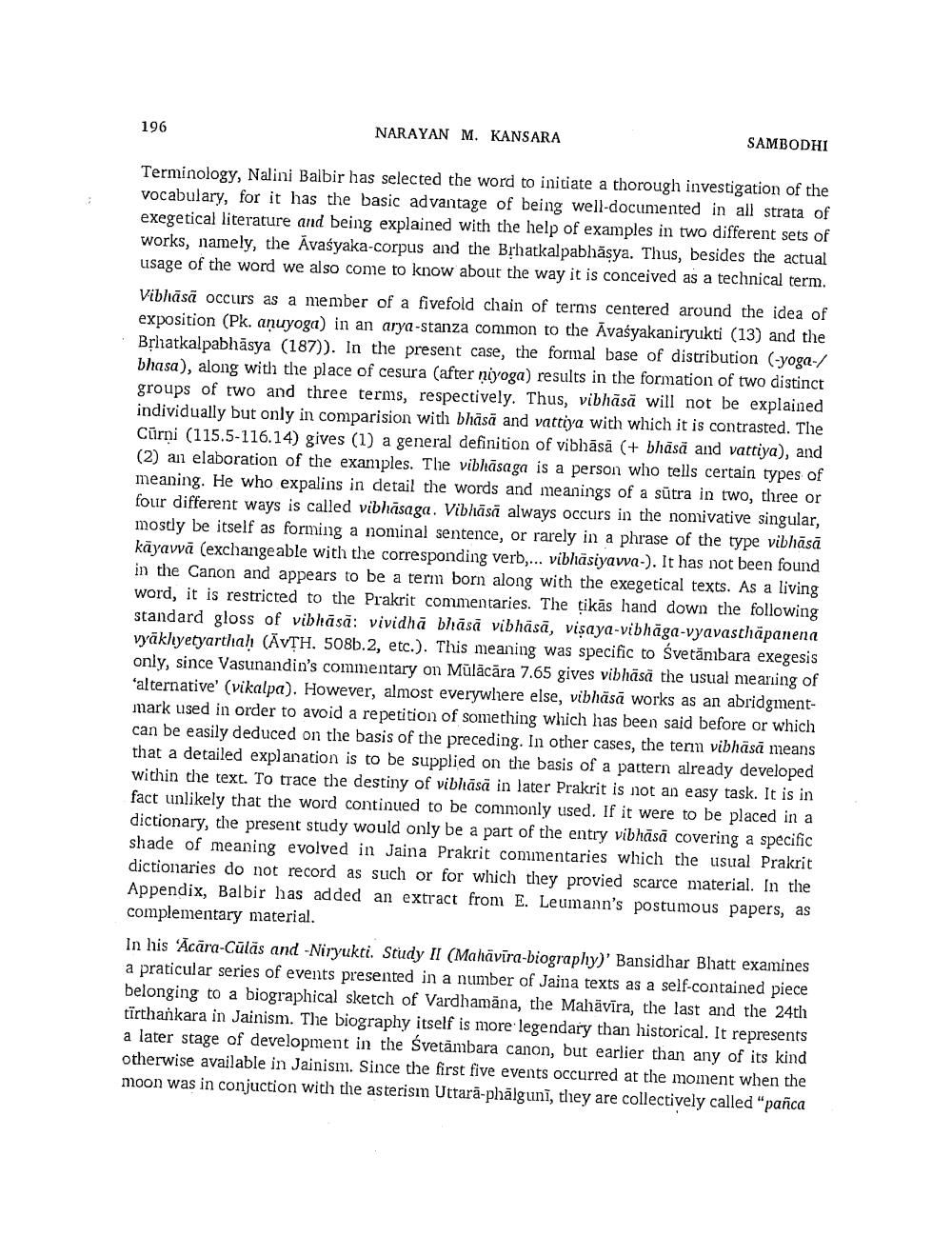________________
196
NARAYAN M. KANSARA
SAMBODHI
Terminology, Nalini Balbir has selected the word to initiate a thorough investigation of the vocabulary, for it has the basic advantage of being well-documented in all strata of exegetical literature and being explained with the help of examples in two different sets of works, namely, the Āvaśyaka-corpus and the Brhatkalpabhāsya. Thus, besides the actual usage of the word we also come to know about the way it is conceived as a technical term. Vibhāsā occurs as a member of a fivefold chain of terms centered around the idea of exposition (Pk. anuyoga) in an arya-stanza common to the Avaśyakaniryukti (13) and the Brhatkalpabhāsya (187)). In the present case, the formal base of distribution (-yoga-/ bhasa), along with the place of cesura (after niyoga) results in the formation of two distinct groups of two and three terms, respectively. Thus, vibhāsā will not be explained individually but only in comparision with bhāsā and vattiya with which it is contrasted. The Cūrni (115.5-116.14) gives (1) a general definition of vibhāsā (+ bhāså and vattiya), and (2) an elaboration of the examples. The vibhāsaga is a person who tells certain types of meaning. He who expalins in detail the words and meanings of a sūtra in two, three or four different ways is called vibhāsaga. Vibhāsā always occurs in the nomivative singular, mostly be itself as forming a nominal sentence, or rarely in a phrase of the type vibhāsā kayavvă (exchangeable with the corresponding verb,... vibhäsiyavva-). It has not been found in the Canon and appears to be a term born along with the exegetical texts. As a living word, it is restricted to the Prakrit commentaries. The tikās hand down the following standard gloss of vibhāsā: vividhā bhāsā vibhāsā, visaya-vibhāga-vyavasthāpanena vyāklyetyarthah (ĀvȚH. 508b.2, etc.). This meaning was specific to svetămbara exegesis only, since Vasunandin's commentary on Mülācāra 7.65 gives vibhāså the usual meaning of 'alternative' (vikalpa). However, almost everywhere else, vibhāsā works as an abridgmentmark used in order to avoid a repetition of something which has been said before or which can be easily deduced on the basis of the preceding. In other cases, the term vibhāsā means that a detailed explanation is to be supplied on the basis of a pattern already developed within the text. To trace the destiny of vibhāsa in later Prakrit is not an easy task. It is in fact unlikely that the word continued to be commonly used. If it were to be placed in a dictionary, the present study would only be a part of the entry vibhāsā covering a specific shade of meaning evolved in Jaina Prakrit conimentaries which the usual Prakrit dictionaries do not record as such or for which they provied scarce material. In the Appendix, Balbir has added an extract from E. Leumann's postumous papers, as complementary material.
In his 'Acara-Cūläs and -Niryukti. Study II (Mahävīra-biography)' Bansidhar Bhatt examines a praticular series of events presented in a number of Jaina texts as a self-contained piece belonging to a biographical sketch of Vardhamāna, the Mahāvīra, the last and the 24th tīrthankara in Jainism. The biography itself is more legendary than historical. It represents a later stage of development in the Svetāmbara canon, but earlier than any of its kind otherwise available in Jainism. Since the first five events occurred at the moment when the moon was in conjuction with the asterism Uttarā-phālgunī, they are collectively called "pañca




